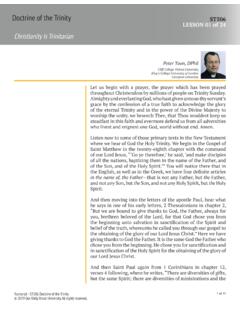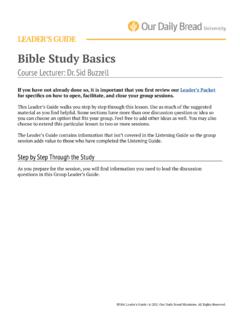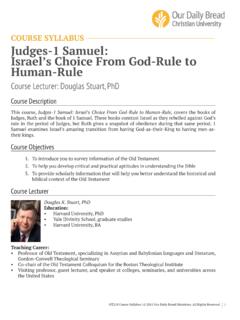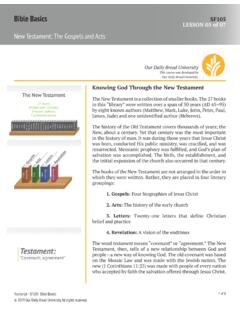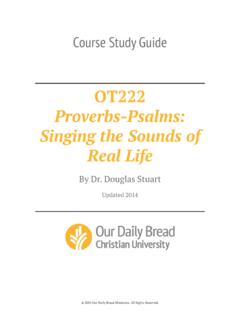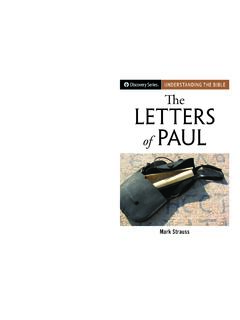Transcription of Doctrine of the Trinity ST506 LESSON
1 Doctrine of the TrinityTranscript - ST506 Doctrine of the Trinity 2019 Our Daily Bread University. All rights of 11 LESSON 21 of 24ST506 Medieval Western CouncilsDoctrine of the Trinity This is the twenty-first lecture in the series on the Doctrine of the Holy Trinity . I begin with the prayer for Trinity Sunday. Almighty and everlasting God who hast given unto us thy servants grace by the confession of a true faith to acknowledge the glory of the eternal Trinity and in the power of the divine majesty to worship the unity. We beseech thee that thou wouldst keep us steadfast in this faith and evermore defend us from all adversities, who livest and reignest one God world without end, the last lecture, which was number 20, you will recall we were looking at the individual contributions of learned theologians from the beginning to the end of what we call the Middle Ages.
2 May I summarize one of the themes of which we were speaking by giving you a way of remembering scholastic theological contribution to the Doctrine of the Holy Trinity , and it is this: you will notice there s a five, four, three, and a two. And I guess we can add a one the one God, but here we go. According to scholastic theology, a notion is what distinguishes each person. There are five notions: innascibility or ingeneratness, paternity, filiation, spiration, procession, the five notions. Four of the five describe relations. Innascibility is the absence of relation. Three of these relations are person-constituting. They are paternity, filiation, spiration. The ternary of relations is derived from the two processions: being begotten and being spirated.
3 And then we speak finally to make up the one of the one God. I strongly commend this to you as a way of remembering the words and the concepts that are used in scholastic theology to seek to portray who is God in Himself, what God is unto Himself in the ontological I wish to do now in this lecture is to look at what we may call the dogmatic development as reflected in the creeds or the statements of councils of the Middle Ages. And this progression of councils and its teaching gives us, according to the Western church, the fully developed Doctrine of the Trinity . Already we Peter Toon, DPhil Cliff College Oxford UniversityKing s College University of London Liverpool UniversityTranscript - ST506 Doctrine of the Trinity 2019 Our Daily Bread University.
4 All rights Western Councils2 of 11 LESSON 21 of 24have looked at the first major solely Western statement. That is the Athanasian Creed, the Quicunque Vult in which, you remember, we spent some time a few lectures ago. The next important creed or statement of a council which gives you a definitive statement of who is God in terms of the Holy Trinity is the creed which was produced by the Council of Toledo, known as the Eleventh Council of Toledo, and it met in 675. It opens thus, We confess and believe that the holy and ineffable Trinity , the Father, the Son, and the Holy Spirit is naturally [that is, by nature] one God of one substance, of one nature, one majesty, and power. The creed of the Council of Toledo goes on to affirm belief in the Father who has origin from no one but is the origin of the Divinity and from whom the Son had birth [eternal birth of course] and from whom the Holy Spirit has procession.
5 And in the Son of God [it is confessed] who is uncreated, coeternal, coequal, consubstantial with the Father, generated by the Father, not by will or not by necessity but from the very substance of the Father without diminution or division of this Godhead, this substantia thus perfect Son of perfect Father. And then confession is made in the Holy Spirit who is the third person in the Trinity , one God coequal and consubstantial with the Father and the Son not begotten nor created but proceeding from the Father and the Son and the Spirit of both, the charity and the holiness of both and sent by both. And so it goes on in terms which are reminiscent of but not identical with those of the Athanasian looking at them and comparing them, we can say of the creed of the Council of Toledo that it goes beyond the Quicunque Vult in the fullness of its Trinitarian teaching.
6 It declares that the Father is the font and origin of the whole divinity. It speaks of the Father of His own essence. And that as you know recalls more the emphasis of the Cappadocians than it does the emphasis of the Latin West. It affirms that the Son is Son by nature and not by adoption and is generated neither by will nor by necessity, thus making clear what is meant by the eternal generation of the Son. Further, it declares that the Holy Spirit not only proceeds from the Father and the Son but is sent by both and is the love or the charity of both. It stresses the relative names of the three persons and their implications, the implications of relative and substantial predication for the Trinity and the application of number to the Trinity .
7 It emphasizes not only the distinction of the persons but also their inseparability in existence, in operation, and in cognition. So it s not difficult to see why this particular creed had a special place in the West and was often cited and often used. So that then is the creed of the Eleventh Council of Toledo from the Transcript - ST506 Doctrine of the Trinity 2019 Our Daily Bread University. All rights Western Councils3 of 11 LESSON 21 of 24year next creed or statement of faith comes from the Fourth Lateran Council of 1215, which the Roman Catholic Church considers to be the twelfth ecumenical council. It has been called by historians the most splendid council of the Middle Ages.
8 It was convoked by the bishop of Rome, Pope Innocent III, and invitations were sent to patriarchs, archbishops, bishops, abbots, and priors not only in the West but also in the East. Now you remember that I referred to this council when we were talking about Peter and his sentences and about the Abbot Joachim. So the council produced a statement entitled Damnamos which is very Trinitarian, in which it condemns Joachim s book and Doctrine . Here it , therefore, with the approval of the sacred council, believe and confess with Peter Lombard [he was the one attacked by Joachim] that there is one supreme reality, incomprehensible, and ineffable which is truly the Father, the Son, and the Holy Spirit at once the three persons taken together and each of them singly, and so in God there is only a Trinity and not a Quaternity.
9 Because each of the three persons is that reality, that is, the divine substance essence or nature which alone is the principle of all things and beside it no other can be found. And that reality is not generating, nor generated, nor proceeding; but it is the Father who generates, the Son who is generated, and the Holy Spirit who proceeds; so that there are distinctions in the persons, unity in the s pretty solid stuff, but you can see what is being said over against the accusations of the abbot that Peter Lombard s book on the sentences was teaching that God is a foursome rather than a Trinity . This particular chapter is framed and has the very obvious title of let me quote to you from the further presentation of this council in which the council, remember that archbishops and bishops were invited from the Eastern church.
10 And there is an attempt here to adopt, as far as is possible, Greek, that is, Greek Orthodox as we now would call them, ways of expressing and thinking about both the distinction between the three persons and the consubstantiality of the three persons. And so we listen now to the council as it declares,Transcript - ST506 Doctrine of the Trinity 2019 Our Daily Bread University. All rights Western Councils4 of 11 LESSON 21 of 24 Although the Father is alius, the Son alius, and the Holy Spirit alius, yet they are not aliud. But what the Father is, that the Son is, that the Holy Spirit is. So that according to the Orthodox and Catholic faith, they are believed to be consubstantial.
